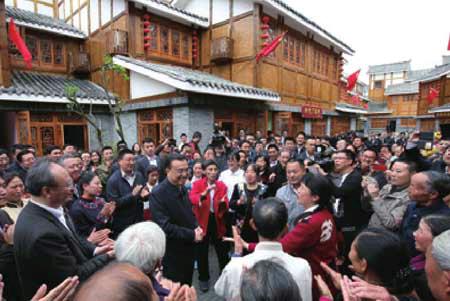Rebuilt Life
2016-05-16
Premier Li Keqiang talks with local residents about infrastructure reconstruction and tourism development in Longmen, an ancient town in Lushan County, southwest Chinas Sichuan Province, on April 24.
In April 2013, a 7.0-magnitude earthquake hit Lushan, killing 196 people, displacing more than 100,000 families and destroying roads and schools.
Law-Making Tasks
Chinese lawmakers will review draft laws on international criminal judicial assistance and national defense transportation this year, according to the plan released on April 22 by the National Peoples Congress (NPC) Standing Committee.
The national defense transportation draft law aims to improve coordination between different departments. This year, laws on environmental protection, tax, public culture services and community correction will also be tabled before the NPC Standing Committee for the first reading.
The top legislative body will also review amendments to laws on the Red Cross Society, maritime environmental protection, water pollution and small and medium-sized enterprises.
The NPC Standing Committee will continue deliberating laws on deep sea resource exploration, charities, management of overseas NGOs and cybersecurity.
Foreign Tibetan Medicine Students
The Tibetan Medical College of Qinghai University said on April 26 that it plans to recruit five foreign postgraduates this autumn. The Masters program will last three years, with students taught in both English and Tibetan.
Established in 1987, the college is one of two higher educational institutions in China which train traditional Tibetan medicine practitioners. The other is in southwest Chinas Tibet Autonomous Region.
Tibetan medicine, known as Sowa Rigpa in Tibetan, is at least 2,300 years old. It has absorbed traditional Chinese, Indian and Arab medicine elements and is mainly practiced in Tibet and the Himalayan region.
Herbs, minerals and sometimes insects and animal parts are used as medical ingredients. It was put on the list of Chinas national intangible cultural heritage in 2006.
GPs Pilot Program
The State Council has published its major healthcare reform initiatives for the year, with a general practitioner (GPs) pilot program, and a reduced reliance on drug revenue for health centers.
This year, 200 cities will trial the pilot program, according to the State Councils statement.
GPs will open their practices to residents, consistently providing them with basic medical services. The plan is part of a tiered health system being rolled out across the country.
To improve local-level medical institutions, the government will allow physicians in public hospitals to have private practice or establish their own practices, according to this years health reforms.
Animal Protection
Some animal species, bred under controlled conditions through mature techniques, could be removed from Chinas special state protection list and regulated differently from wild populations, according to the newest revisions to the countrys wild animal protection law.
For instance, the Sika deer bred in controlled environments could be removed from the list, as the captive breeding of this species started centuries ago, the Law Committee of the National Peoples Congress (NPC) said in a report. It cited suggestions on the first version of the revised draft of the law, which was tabled for first reading last December.
The newest revised draft, which was tabled for second reading on April 25, said carrying out captive breeding programs removed from the state protection list will require permits from the authorities. The sale and utilization of such animals require special tags issued by the authorities to ensure their traceability.
Regulating animal populations bred in captivity and those in the wild in a different way is consistent with internationally accepted practices, the NPC Law Committee said in the report, citing the suggestions.
Software Copyright Registration
China processed more than 920,000 new software copyright registrations between 2011 and 2015, 3.8 times the number in the previous five years, according to statistics released on April 26. Registrations rose from around 100,000 in 2011 to nearly 300,000 in 2015.
This works out to an average annual increase of nearly 29 percent over the period, said the report on software copyright registration, issued by the Copyright Protection Center of China, a semi-governmental organization.
During this period, two thirds of new software copyrights originated in Beijing, Shanghai and the three coastal provinces of Guangdong, Jiangsu and Zhejiang.
The increase related to the Internet of Things was the largest, while registrations for apps also rose significantly.
China began to register software copyrights in 1992.
S&T Human Resource
Personnel involved in scientific research and technology development in China had reached 81.14 million, the most in the world, by the end of 2014, said a research report.
The report on Chinas science and technology human resource in 2014, issued by China Association for Science and Technology, said the statistics cover people who have obtained a natural science diploma above the junior college level and those who do S&T related jobs despite lacking a diploma.
By the end of 2014, 76.21 million people belonged to the first category and 4.93 million to the second, according to the report.
The profiled average age is 34 and 36.6 percent are women; 68.3 percent of them either have a degree or work in the field of engineering, medicine, science or agriculture.
Reusing Manned Spacecraft
China is studying how to retrieve and reuse manned spacecraft for future missions, said Zhou Jianping, chief engineer of the nations manned space program, on April 24.
“Our next goal is to reuse manned spacecraft. We want to make our space exploration cost-effective,” Zhou said as China marked Space Day, newly designated by the government to commemorate the countrys first satellite launch on April 24, 1970.
Reusable manned spacecraft are a Holy Grail of space exploration. The United States developed partially reusable manned spacecraft capable of reaching low Earth orbits. But they were all retired in 2011 due to high costs and risks, including an accident in 2003 that killed seven astronauts.
Zhou did not go into any more details on the project, but stressed his teams focus on cost saving, giving an example from the Tiangong space lab series.
Tiangong-1 was due to be followed by Tiangong-2 and Tiangong-3, but Chinese scientists managed to incorporate all tasks planned for the third generation of the lab into Tiangong-2, he said. There has been no need to develop Tiangong-3.
Chinas space station, to be completed around 2022, will be a“green model, with highly advanced and budget-saving facilities in flight control, power supply and waste recycling,” according to Zhou.
Earlier this month, U.S. rocket developer SpaceX achieved a world first by landing a Falcon rocket on a carrier at sea.
China paid close attention to the innovation and is testing its own reusable rockets, promising a breakthrough before the end of 2020, according to earlier reports.
Reading Wonder
The Zhongshuge Bookstore in Shanghai puts its new branch in Hangzhou into trial operation on April 23, World Book Day.
The local bookshop brand opened its first store in Shanghais Songjiang District in 2013. It has been dubbed the “most beautiful bookstore” for its stylized interior decoration.
Nuclear Advancement
Visitors view an ion cyclotron resonant heating antenna, a key part of nuclear fusion facility, at the Chinese Academy of Sciences Institute of Plasma Physics in Hefei, Anhui Province, on April 25.
The world-class antenna, manufactured by the institute, was delivered to a French organization in Anhui.
Stable Job Market
Chinas registered unemployment rate in urban areas stood at 4.04 percent at the end of March, down from 4.05 percent at the end of 2015, the Ministry of Human Resources and Social Security said on April 22.
An additional 3.18 million urban jobs were created in the first three months of 2016, ministry spokesperson Li Zhong said at a press conference.
“The data indicates that Chinas job market remains stable,” Li said, attributing the increase and low unemployment rate to the “slower but reasonable economic growth, the governments deepened reform and innovation drive, as well as proemployment policies.”
Creating more jobs is one of the Chinese Governments priorities to keep employment stable as millions of workers face redundancy due to mergers and reorganization in industries faced with overcapacity. China aims to provide more than 10 million new urban jobs in 2016 and keep the registered urban unemployment rate below 4.5 percent.
‘Internet Plus Plan
Investment in broadband Internet in rural areas, support for the development of virtual reality(VR) and encouragement of the sharing economy are highlights of an action plan drawn by the State Council for integrating online and offline commerce.
The government will support more use of mobile Internet, the Internet of Things and big data in marketing, payment and after-sale services to meet consumer needs and reduce consumption costs, according to an “Internet plus commercial circulation” plan released on April 21.
There will be preferential measures to help the construction of logistics and cold chain infrastructure. Under the plan the government will increase spending on such facilities.
Better Internet connections in rural areas and lower Internet service charges will narrow the “digital divide” with urbanites.
The document backed the research and development of VR as well as of wearable devices and suggested more e-commerce firms and farm produce sellers form partnerships.
Local governments were asked to set up funds to support ecommerce and to channel private and overseas capital into the sector.
Automobile Show
Chinese automaker Eventmotors displays its electric car at the Beijing International Automotive Exhibition (BIAE) on April 25. The 14th BIAE opened that day with more than 1,600 automobile producers from 14 countries and regions joining the auto show.
Business Sentiment Improves
Business sentiment in China is improving as the economy shows signs of stabilizing, new analysis showed on April 22.
Financial information provider Market News Internationals reading of business sentiment came in at 50.5 in April, up from 49.9 in March.
The indicator, which has been released every month since 2007, is based on polls of Chinese business executives on business conditions and economic expectations.
The latest increase was in contrast to an average decline of 0.9 percentage points between March and April over the 2011-15 period, Japanese securities trader Nomura said in an analysis note.
Another indicator also pointed to firmer economic stabilization. The manufacturing activity index for small and medium-sized enterprises, released by China Minsheng Bank and China Academy of New Supply-side Economics, climbed 3.3 percentage points to 46.9 in April.
Supporting Entrepreneurship
The International Finance Corp.(IFC), an arm of the World Bank, announced on April 25 it has invested$15 million in China Innovation Works to support entrepreneurship in China.
The investment will go toward Sinovation Fund III LP, a venture capital fund that focuses on early and mid-stage Internet companies in China. It is the first time that the IFC has invested in such programs in China.
Innovation and entrepreneurship have become Chinas new growth engines. They have benefited from increased government policy support of innovation spaces, which the government hopes will boost industrial upgrades and employment.
The IFCs development priorities in China include clean energy, consumption and technology in innovation fields such as education, the Internet and finance.
Kai-fu Lee, founder of China Innovation Works, pointed out that the IFCs investment will help them promote its innovative business model of “investment plus incubation,” which has created a strong incubation ecosystem in China, helping mentor local entrepreneurs and provide them with resources both domestically and internationally.
Trading Fees Rise
Chinas major futures exchanges have raised trading fees for some futures as risk of overheating loom following days of rapid price increases and alarmingly high market turnover.
Beginning on April 25, the Shanghai Futures Exchange raised the trading fees for hot-rolled steel coils, screw thread steel and petroleum asphalt to 0.01 percent from the current 0.004 percent, 0.006 percent and 0.008 percent, respectively.
Also starting on April 25, the Dalian Futures Exchange raised the trading fees for iron ore and polypropylene to 0.009 percent.
Investors are betting on continued price rebounds as the general economy has shown tentative signs of warming while industry data offered hope of improved supplydemand curves.
The government hopes to prevent huge market swings that could derail the nascent economic recovery.
Green Bond Issuer
China replaced the United States as the top issuer of green bonds geographically in the first quarter of 2016, credit rating agency Moodys said in a report.
Chinese institutions issued $7.9 billion worth of green bonds in the first three months of this year, nearly half of the global total, according to the report.
Spurred by transactions initiated by China-based financial institutions global green bond issuance reached$16.9 billion from January to March, nearly three times the volume seen in the same period last year and above the $15.2 billion seen in the fourth quarter of 2015, the report said.
A green bond is an innovative financing method used around the world, directing financial resources to environmental protection.
The Chinese mainlands first green bond was issued by the Agricultural Bank of China and listed on the London Stock Exchange in October 2015.
Overseas Production Base
The picture shows a Haier refrigerator production line in Naberezhnye Chelny city in Russia on April 22. That day, Haier officially opened its first Russian plant in the citys Master Kama Industrial Park.
China Presence
Fair-goers try virtual reality glasses at Huaweis stand at the Hanover Fair in Germany on April 26. Some 700 exhibitors from China, second only to the host country in terms of the number of exhibitors, attended the fair.
Cross-Border Acquisition
The Aviation Industry Corp. of China(AVIC) has acquired a 95-percent stake in Spanish company Aritex, the Chinese state-owned enterprise said on April 27.
During a ceremony held in the northeastern Spanish city of Barcelona, Aritex said the acquisition was completed thanks to cooperation between the two companies.
Established in 1981 as a supplier of industrial products for the automobile sector, Aritex diversified its activity to the aerospace sector in 2001.
Aritex will focus on research technologies and add new companies to the value chain, Aritex General Manager David Lopez said, noting that this was a win-win relationship highlighting strong commitment to bringing best technology for costumers.
Describing Aritex as one of the most important producers in Europe, AVIC Chairman Wu Guangquan said that after the acquisition, his company expects to take part in the global industry at a higher level.
